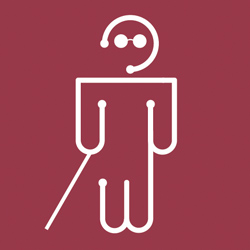Summary
The task of navigating through new spaces can often be challenging for People with Visual Disabilities until they get acquainted with the pathways and key landmarks. This applies to both indoor and outdoor spaces. When it comes to outdoor spaces, the availability of Global Positioning Systems (GPS) means that there are plenty of solutions available that aid everyone in navigating streets, sidewalks and over ground public transportation systems. When it comes to indoor spaces, where satellite signals required to operate GPS are not available, blind people face tremendous challenges in finding wayfinding systems.
Completed
Target Users
User Journey
 Khaled is a 40-year-old blind man. He has travelled on his own to a new convention center in Qatar to give a presentation.
Khaled is a 40-year-old blind man. He has travelled on his own to a new convention center in Qatar to give a presentation.
1
Upon entering the building, Khaled wants to know where room 105B is.
2
Having downloaded the convention center app on the way to the venue, he opens the app to try and find his way to room 105B.
3
Using a wayfinding system, he can independently navigate his way to room 105B.
4
After delivering the presentation, he uses the same wayfinding system to find the nearest men’s bathroom and then how to get to the exit nearest the adjoining metro station.
Potential Service Features
- WCAG 2.1 AA compliance
- Personal profile for navigation preferences
- Compatibility with wearables
- Language independence
- Text to speech compatibility
- Emergency system push notifications
Touch Points
Issue Statement
The unavailability of indoor wayfinding systems means that most people with visual disabilities are unable to extend the functionality of GPS to buildings, leaving them without any navigation support.
Expected Key Benefits
Increased independence for people with visual disabilities through the provision of effective, accessible and dynamic indoor wayfinding systems.
Implementation Analysis
Implementation Timeline
![]()
Low
Medium
High
Technology Commercial Viability
![]()
Available Now
Viable in Short Term
Viable in Long Term
Investment Requirements
![]()
Low
Medium
High
Key Implementation Considerations
1
Real life situation user testing with people with visual disabilities
2
Accuracy of indoor wayfinding
